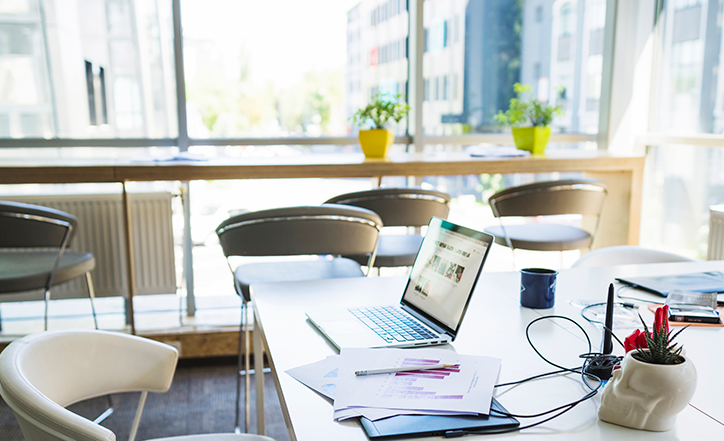What will the office look like Post COVID-19?

April 25, 2020
Assuming your business is not considered an “essential service” it is likely that you and your business have been thrown into a massive work-from-home experiment. As the experiment continues and the curve begins to flatten, let’s consider how the local workplace may look once it’s deemed safe to return to the office.
Occupiers:
It’s safe to say that the re-opening of American offices will come in waves to mitigate the risk of a second outbreak. When offices open back up, employers will likely be hyper-conscious about their employees’ health and wellbeing, limiting face to face interaction and office densities to limit the potential spread of bacteria.
We will likely see a newfound acceptance of work-from-home mobility strategies as certain management teams who have long-fought against it are now realizing “it’s not that bad.”
We’re seeing some governmental entities adjusting the permissible office density to make offices less dense; however, most users aren’t getting near that number (in Miami-Dade, 100 USF/employee for example). Most occupiers will likely relieve their stringent corporate standards to allow for a less-dense office, which coupled with a flexible work-from-home program will ultimately result in a net neutral change for office space requirements. Immediately, individual seating arrangements will likely be adjusted to comply with the 6 feet guidelines provided by the CDC (if not already). In the long-run, architects will start designing workplaces with hygiene and prevention as a main consideration.
In summary, it is unlikely that we’ll see an immediate drastic change in the way the modern office looks. Users will adapt to things that worked during this time of disruption while being mindful of reducing the possibility of future disruption. The office remains a place to work, collaborate, inspire and create new ideas; and it’s not going anywhere.
Buildings:
Office buildings and their owners will be hyper-focused on ensuring their tenants’ health and safety as we overcome this challenge. We can expect modernization of doors, bathrooms, elevators, and drinking fountains (among others) to require little to no human touch to reduce the spread of germs.
Air quality will be scrutinized more closely as is common in some European markets, but it is unlikely that this will sway the decisions of too many occupiers looking for a new home. Tenants will take a closer look at a building’s janitorial services and Landlords will have to maintain a high standard of cleanliness or allow for an expanded service if tenants request it.
Elevator densities will likely be temporarily decreased depending on size to cooperate with CDC guidelines of 6 feet but it’s difficult to imagine never having an early morning elevator cab ride with 8+ of your closest office neighbors.
We’ve already seen a flight to quality trend in tenant decision making. We suspect this will urge landlords to improve their buildings and further benefit those landlords with a superior product.
Leases:
Attorneys have been flooded with force majeure questions since stay-at-home ordinances have been put in place. Due to the dynamics between owners and lenders, it is difficult to imagine that it will become widely acceptable by landlords to include a Force Majeure or Service Interruption clause that would relieve tenants of their rental obligations in the event of another pandemic moving forward. Some ancillary costs such as parking may, however, be contractually waived in the event a tenant is unable to utilize their premises for an extended period due to a pandemic or similar situation.
Nevertheless, tenants will look to mitigate future risks and this will likely be pushed to insurers.
Preparing to return to the office:
As we look beyond this unprecedented time, it will soon be time to start thinking about how best to prepare the office for employees to return. More to come from that in an upcoming post.